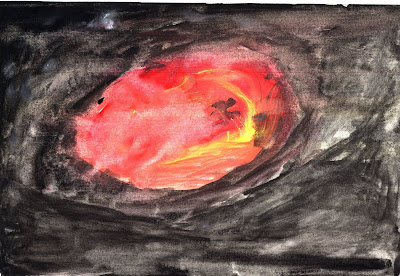Watching the boys over the last few days, we were struck by the fact that much of their learning is "top-down" or "radial", and hardly ever "bottom-up"
For a long while now, they have been involved with Space, the Universe, Planetary Probes and so on.
All of us go out every night post-dinner, star chart in hand, to see if the clouds will allow us to star-gaze. Great excitement when we spotted Jupiter one night.
The boys' outdoor games are to do with going to various planets. They make Lego models of Phoenix, Sojourner and various other Space probes/landers/rovers. Paper models are also aplenty, some of their own designing, some whose templates have been downloaded from various websites.
Badri has a list of some 30 probes to Mars.
Both Badri and Varun have projects on the Scratch site with maps of Venus, Mars and other planets.
They have a 3D-visualization, which I for one, envy. Something that has never occurred to me, which Badri Baba remarked on, in passing, while talking about conventions and "people do it that way" was that one could draw maps of the earth with S America on top and N America below; the whole world flipped upside down. All it means is that you are looking at the Solar System from the "bottom" and the planets are revolving clockwise around the sun rather than counter-clockwise as is usually depicted.
Whilst doing all this, various questions crop up:
Stability: Why does Spirit have three sets of equal sized wheels? Why does a tractor have two unequal sets of wheels?
Scale: Something that is never clearly explained and as a result of which many of us carry around a wrong picture in our heads of the sun and the planets orbiting it.
One cannot draw on an A4 paper an accurate rendering of the Solar System with the planets' sizes and their orbits to the same scale.
Fine. But surely , we should not be looking at pictures that are "strongly" elliptical. Aphelion (Greatest distance of earth from sun) and Perihelion (Least distance of earth from sun) occur 180 degrees from each other, not 90 degrees as suggested by almost all the diagrams we see.
Co-ordinates: Why can't x and y co-ordinates be called h(orizontal) and v(ertical) co-ordinates to avoid confusion? Why not indeed!
The point I am trying to make is that if kids (or adults for that matter) plunge into some subject that interests them, there are bound to be difficulties. But surely, these can be surmounted, taking into account the understanding-level of the kid concerned.
To insist on sequential learning as devised by adults, is a sure way to kill the spontaneous interest and consequent energy generated to learn something new.
To insist on being able to spell "Jane, see Spot run", before spelling Phoenix and Cassini-Huygens will probably lead to "reading difficulties" which is actually boredom by another name.


